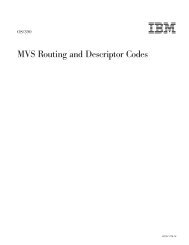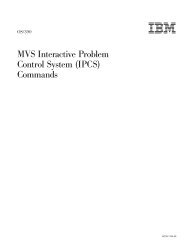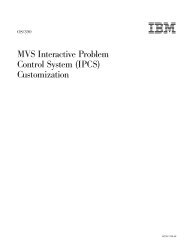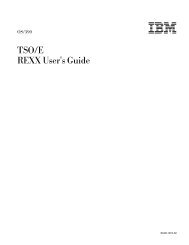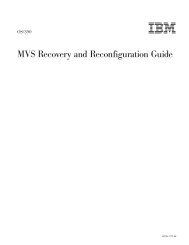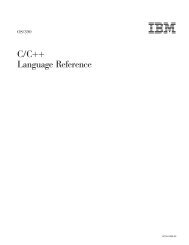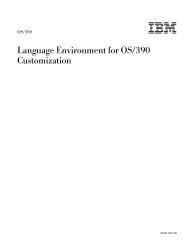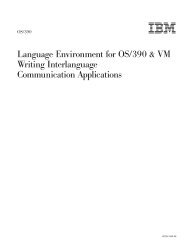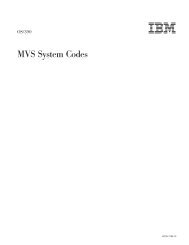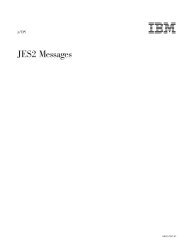OS/390 MVS IPCS User's Guid
OS/390 MVS IPCS User's Guid
OS/390 MVS IPCS User's Guid
Create successful ePaper yourself
Turn your PDF publications into a flip-book with our unique Google optimized e-Paper software.
Other Pieces of <strong>IPCS</strong><br />
For example, if you have installation-defined dump exits that were previously in<br />
<strong>MVS</strong>/XA SP load module AMDPRECT, you can add them to BLSCUSER.<br />
PRDMP<br />
Print dump (PRDMP) is a service aid that <strong>IPCS</strong> replaced in <strong>MVS</strong>/ESA SP Version 3.<br />
Most of PRDMP’s functions are now available through <strong>IPCS</strong> subcommands and exit<br />
routines. An appendix in <strong>OS</strong>/<strong>390</strong> <strong>MVS</strong> <strong>IPCS</strong> Commands gives the equivalent<br />
PRDMP functions in <strong>IPCS</strong>.<br />
Problem and Data Set Management<br />
<strong>IPCS</strong> has facilities to keep track of problems with your system and dump data sets<br />
stored on the system. However, you usually do not need to use these facilities. The<br />
Information/System family of products provides the same function.<br />
How <strong>IPCS</strong> Works as a TSO/E Application<br />
<strong>IPCS</strong> is a problem-state, key 8 program that runs in a TSO/E user’s address space.<br />
<strong>IPCS</strong> operates in interactive and batch environments supported by TSO/E.<br />
The base of <strong>IPCS</strong> is a TSO/E command processor. The TSO/E command “<strong>IPCS</strong>”<br />
activates the <strong>IPCS</strong> command processor. All commands used to perform <strong>IPCS</strong><br />
functions are “subcommands” of the <strong>IPCS</strong> command. You can use <strong>IPCS</strong> functions<br />
from any TSO/E line mode session.<br />
For interactive use, the <strong>IPCS</strong> dialog uses ISPF dialog support to run as an<br />
interactive, full-screen application. This application uses the <strong>IPCS</strong> command<br />
processor. Figure 2 shows where the <strong>IPCS</strong> command processor and <strong>IPCS</strong> dialog fit<br />
in the system. Note that the <strong>IPCS</strong> command processor environment is not available<br />
from ISPF; you cannot invoke <strong>IPCS</strong> subcommands directly from the ISPF dialog.<br />
Figure 2. <strong>IPCS</strong> as a TSO/E Application<br />
A set of data set libraries contain the code to run <strong>IPCS</strong>. Table 1 lists these data<br />
sets.<br />
Table 1. Libraries that Contain <strong>IPCS</strong> Code<br />
Data Set<br />
Contents<br />
SYS1.HELP<br />
TSO/E HELP data for <strong>IPCS</strong> commands and subcommands<br />
SYS1.MIGLIB<br />
<strong>IPCS</strong> code<br />
Chapter 1. Introduction to <strong>IPCS</strong> 9



